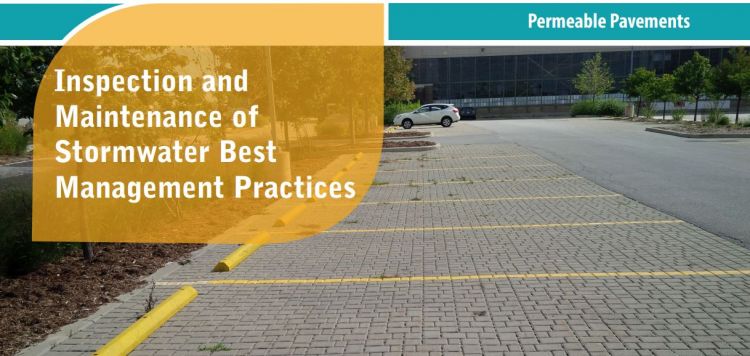Inspection and Maintenance: Permeable Pavement

Overview[edit]
Permeable Pavement Permeable pavements contain many small openings (i.e., joints or pores) that allow rainfall and snowmelt (i.e., stormwater) to drain through them instead of running off the surface as it does on impervious pavements like conventional asphalt and concrete. An overflow outlet is needed to safely convey flows during flood events. Depending on the permeability of the underlying soil and other constraints, the pavement may be designed with no sub-drain for full infiltration, with a sub-drain for partial infiltration, or with an impermeable liner and sub-drain for a no infiltration practice. The sub-drain pipe may feature a flow restrictor (e.g., orifice cap or valve) for gradually releasing detained water and optimizing the amount drained by infiltration into the underlying soil.
Key components of Permeable pavements to pay close attention to are the:
Associated Practices[edit]
- Permeable Interlocking Pavers (i.e., Block Pavers) – Precast modular units made of concrete, pervious concrete or rubber/plastic composite designed to create open joints between pavers that are filled with fine, washed aggregate and installed on an open graded aggregate (i.e., clear stone) base and sub-base.
- Permeable Interlocking Grid Systems (i.e., grid pavers) – Precast concrete or manufactured plastic grids with open cells that can be filled with aggregate or a mixture of sand, gravel and topsoil and planted with grass or low-growing ground covers and are installed on an open-graded aggregate base.
- Pervious Concrete – a rigid pavement installed on an open-graded aggregate base that uses a cementitious binder to adhere aggregate together, similar to conventional concrete, except that the fine aggregate component is minimized or eliminated which results in the formation of connected pores throughout.
- Porous Asphalt – a flexible pavement installed on an open-graded aggregate base that uses a bituminous binder to adhere aggregate together, similar to conventional asphalt, except that the fine aggregate component is minimized or eliminated which results in the formation of connected pores throughout.
Inspection and Testing Framework[edit]
- ↑ TRCA. 2016. Fact Sheet - Inspection and Maintenance of Stormwater Best Management Practices: Permeable Pavement. https://sustainabletechnologies.ca/app/uploads/2018/02/Permeable-Pavement-Fact-Sheet.pdf